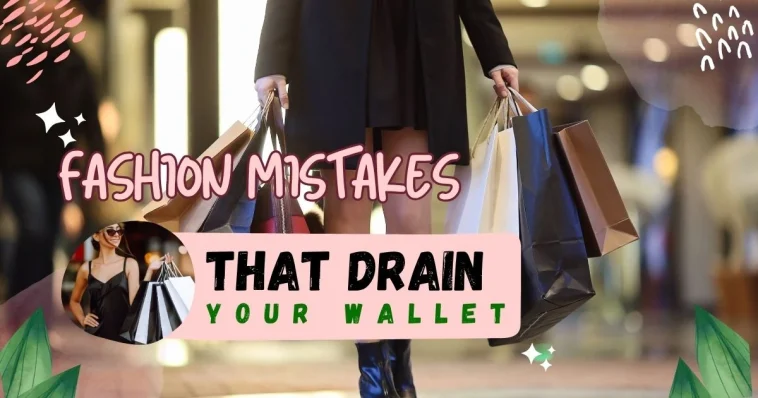Shopping should feel fun, not like donating to a landfill with your credit card. Yet every year, millions of dollars are quietly flushed away on impulse buys, poorly made items, and trends that vanish faster than your receipt. This guide walks you through the most common fashion mistakes that waste your money, shows why they are costly, and gives practical fixes plus up-to-date brand and product ideas for 2025 so you can look great while spending smarter.
Stop Making Fashion Mistakes That Waste Your Money
1. Buying For Trends Instead Of Wearability
Why Does It Waste Money
Trends arrive fast and leave faster. You might love a viral silhouette now, but if it does not fit your life, you will not wear it beyond a single season. Cost per wear is the simplest way to judge value. A cheap item worn once becomes expensive per wear.
How To Fix It
Before you buy, ask: where will I wear this? How does it pair with ten things I already own? If you cannot picture five real outfits, skip it. Build a capsule of timeless basics you actually reach for, then add a few statement pieces that you truly love.
Where To Start In 2025
Editors and stylists are doubling down on capsule staples for 2025: classic outerwear, tailored trousers, and minimalist bags that can move from day to night. Publications tracking seasonal wardrobes recommend investing in a few elevated basics rather than chasing every new silhouette.
2. Prioritizing Brands Over Fit And Quality
Why Does It Waste Money
A logo does not guarantee longevity. Paying full price for a designer label that fits poorly is still a loss. Conversely, a well-fitting piece from an affordable, quality brand will be worn again and again.
How To Fix It
Try clothing on, check how seams sit and how sleeves fall, and pay attention to fabric weight. If you cannot try in-store, read the measurements and return policies carefully. Learn basic tailoring — small adjustments often turn a so-so purchase into a wardrobe staple.
Brand Suggestions That Balance Quality And Price
For everyday staples that are designed to last and are popular in capsule wardrobes, look at brands like Everlane, ARKET, and Uniqlo. They are cited frequently in 2025 roundups for offering solid basics at reasonable prices.
3. Ignoring Care Instructions And Fabric Quality
Why Does It Waste Money
Cheap fabrics and improper care make garments pill, fade, stretch, or lose shape. Replacing items that fall apart after a few washes adds up fast.
How To Fix It
Read the care label before you buy. Natural fibers like wool, cotton, silk, and linen often last longer if cared for properly. For many items, gentle cycles, cold water, and air drying prevent damage. Learning a little garment care is one of the cheapest investments you can make.
Practical Buys To Make Your Clothes Last
Invest in shoe trees for leather shoes, a fabric shaver for pills, and a simple sewing kit to fix loose buttons. For sweaters, midmarket brands such as Quince now offer high-quality knitwear at accessible prices, which can reduce how often you replace items.
4. Falling For Fast Fashion Bargains That Do Not Last
Why Does It Waste Money
Fast fashion gives you low prices today, but often leads to frequent replacements. The real cost is how often you must buy the same or similar item over and over.
How To Fix It
Limit fast fashion purchases to true trend experiments that you accept may be short-lived. For everyday pieces, choose higher-quality alternatives or secondhand options.
Sustainable And Affordable Alternatives In 2025
There is a growing list of affordable, more sustainable brands and outlets in 2025 that aim to combine quality with better practices. Resources that track ethical brands can help you find options that are both budget-friendly and less wasteful.
5. Buying Without A Wardrobe Plan
Why Does It Waste Money
Shopping with no strategy leads to duplicates, mismatched items, and pieces that never make it out of the closet. That racks up the cost-per-wear and fills home storage.
How To Fix It
Do a closet audit twice per year. Keep a running list of gaps rather than buying on impulse. A simple rule: for every new item, ensure it complements at least three existing pieces.
Tools And Systems That Help
Many fashion sites and personal stylists now promote capsule planners and wardrobe checklists. Adopting one keeps purchases intentional and dramatically reduces wasted buys.
6. Overpaying For “Sustainable” Claims Without Verification
Why Does It Waste Money
Greenwashing is common. Some brands use vague language about being eco-friendly while their products still have opaque supply chains. Paying a premium for vague sustainability claims does not always mean buying better.
How To Fix It
Look for measurable credentials: B Corp certification, verified material claims, transparent supply chains, and third-party audits. Read brand pages for specific evidence rather than marketing language.
Brands Doing Sustainability With Clarity In 2025
Journalism and industry trackers in 2025 highlight brands that combine transparency and measurable practice. When you want to spend more for better environmental outcomes, pick companies with clear, verified claims rather than unsubstantiated promises.
7. Skipping Resale And Secondhand Markets
Why Does It Waste Money
You lose all resale value when you toss or give away perfectly wearable clothing. Buying new for every need ignores a huge secondhand market that can save money and find higher-quality pieces at lower prices.
How To Fix It
Resale apps and marketplaces are now mainstream. Before you buy new, check the secondhand channels for the same or similar items. When you do purge, sell the wearable pieces to recover part of your spend.
Resale Platforms To Know In 2025
Depop, Poshmark, and other resale apps remain central to the secondhand economy in 2025. These platforms make it easier to buy and sell preloved clothing, and many shoppers now rely on them to score quality items at steep discounts.
8. Neglecting Accessories And Shoe Investment
Why Does It Waste Money
Shoes and bags show wear quickly and can ruin an outfit if they’re cheap. Conversely, investing in a few well-made accessories elevates many looks and reduces the need for extra clothing purchases.
How To Fix It
Spend a bit more on shoes and a great bag that will last. Look for comfortable construction and repairable materials. Rotate shoes to let them breathe and use protectors for leather.
Product Ideas That Give Bang For Your Buck
Brands like Allbirds and Veja are noted for combining style and durability in casual shoes. For work and dress options, choose classic silhouettes in leather that can be resoled or repaired.
9. Buying The Wrong Size And Hoping For A Change
Why Does It Waste Money
Purchasing clothing in the wrong size “for later” rarely works out. If it does not fit now, you will not wear it. The money spent sits in the closet until it becomes a donation.
How To Fix It
Buy for the shape you have now. Tailoring is a great investment; a well-tailored, affordable garment will outperform an expensive off-the-rack piece that never fits properly.
How To Shop Smart Online
Measure yourself and compare to size charts. If returns are free, try two sizes and return the one that fits less well. Brands that publish detailed measurements and fit notes reduce return rates and save you money.
10. Not Using Warranty, Repairs, And Buy-Back Programs
Why Does It Waste Money
Warranty and repair programs help garments last longer, and buy-back or takeback services can extract value from items you no longer want. Ignoring these reduces potential savings.
How To Fix It
Ask about repair services before you buy. Use brand takeback or resale programs to resell or recycle items. Many companies offer repairs, and some accept returns for resale or recycling.
Programs Worth Checking In 2025
An increasing number of brands and retailers offer repair and takeback options. When you select products, factor in post-purchase servicing as part of long-term value.
11. Falling For Influencer And Microtrend Hype
Why Does It Waste Money
In 2025, social media trends move at lightning speed. Viral aesthetics like “clean girl” or “mob wife” can push you to buy outfits that do not suit your lifestyle. These impulse purchases quickly lose appeal, leaving you with unworn clothes and wasted money.
How To Fix It
Smart Ways To Stay Inspired In 2025
A growing number of fashion creators and stylists now promote mindful consumption and creative restyling instead of constant newness. You can also use AI wardrobe apps like Whering or Smart Closet to digitally catalog your clothing and try out combinations virtually before buying anything new.
Final Checklist: Spend Smarter In Five Minutes
- Ask: Will I wear this at least 30 times?
- Check fit and fabric before buying.
- Verify sustainability claims or skip the premium.
- Look on resale sites for the same item.
- Prioritize shoes, bags, and tailoring.
Spend With Intention, Not Impulse
Fashion should reflect who you are, not your impulse spending. The simplest rule for avoiding wasteful purchases is to buy with intention. Treat clothing as a utility and an expression. Invest in items that integrate into your life, learn a few care and repair skills, and use resale markets when you need variety. In 2025, the options for intelligent shopping are better than ever. With a small shift in habit, you will spend less, feel better in what you wear, and add real value to your wardrobe.



